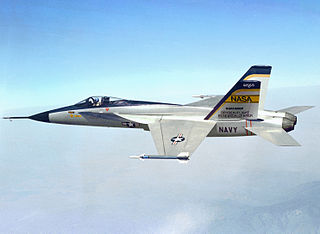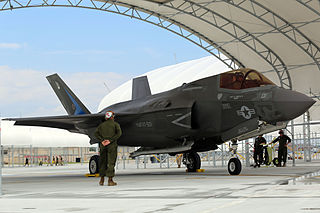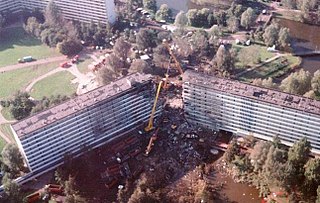
The Blue Angels, formally named the U.S. Navy Flight Demonstration Squadron, are a flight demonstration squadron of the United States Navy. Formed in 1946, the unit is the second oldest formal aerobatic team in the world, after the French Patrouille de France formed in 1931. The team, composed of six Navy and one Marine Corps demonstration pilot, fly Boeing F/A-18 Super Hornets.

The McDonnell Douglas F/A-18 Hornet is an all-weather supersonic, twin-engine, carrier-capable, multirole combat aircraft, designed as both a fighter and attack aircraft. Designed by McDonnell Douglas and Northrop, the F/A-18 was derived from the latter's YF-17 in the 1970s for use by the United States Navy and Marine Corps. The Hornet is also used by the air forces of several other nations, and formerly by the U.S. Navy's Flight Demonstration Squadron, the Blue Angels.

The Northrop YF-17 is a prototype lightweight fighter aircraft designed by Northrop aviation for the United States Air Force's Lightweight Fighter (LWF) technology evaluation program. The LWF was initiated because many in the fighter community believed that aircraft like the F-15 Eagle were too large and expensive for many combat roles. The YF-17 was the culmination of a long line of Northrop designs, beginning with the N-102 Fang in 1956, continuing through the F-5 family.

Marine Corps Air Station Beaufort or MCAS Beaufort is a United States Marine Corps (USMC) air base located 5 kilometres (3.1 mi) northwest of the central business district of Beaufort, a city in Beaufort County, South Carolina, United States. About 4,700 personnel serve at the station, and it is home to four Marine Corps F/A-18 Hornet fighter-attack squadrons and one F-35B Lighting II training squadron.

Marine Corps Air Station Miramar, formerly Naval Auxiliary Air Station (NAAS) Miramar and Naval Air Station (NAS) Miramar, is a United States Marine Corps installation that is home to the 3rd Marine Aircraft Wing, which is the aviation element of the 1st Marine Expeditionary Force. It is located in Miramar, San Diego, California, about 14 miles (23 km) north of Downtown San Diego.

Naval Air Station (NAS) Oceana or NAS Oceana is a United States Navy Naval Air Station located in Virginia Beach, Virginia.

Marine All Weather Fighter Attack Squadron 224 is a United States Marine Corps F/A-18 Hornet squadron. Also known as the "Fighting Bengals", the squadron is based at Marine Corps Air Station Beaufort, South Carolina and falls under the command of Marine Aircraft Group 31 (MAG-31) and the 2nd Marine Aircraft Wing. The Bengals are the only Marine F/A-18D Hornet Squadron currently operating out of MCAS Beaufort.

Strike Fighter Squadron 113 (VFA-113), also known as the "Stingers," is a United States Navy strike fighter squadron based at Naval Air Station Lemoore, California. They are an operational fleet F/A-18E Super Hornet squadron attached to Carrier Air Wing 2 (CVW-2) and based at NAS Lemoore, California. Their tailcode is NE and their radio callsign is Sting.

Strike Fighter Squadron 106 (VFA-106), also known as the "Gladiators", is a United States Navy F/A-18 Hornet and F/A-18E/F Super Hornet Fleet Replacement Squadron stationed at Naval Air Station Oceana, Virginia.

Strike Fighter Squadron 125 (VFA-125), also known as the "Rough Raiders", is a United States Navy strike fighter squadron based at Naval Air Station Lemoore, California. The "Rough Raiders" are a Fleet Replacement Squadron flying the F-35C Lightning II.
The 2007 Blue Angels South Carolina crash occurred on April 21, 2007, when the Number 6 US Navy Blue Angels jet crashed during the final minutes of an air show at the Marine Corps Air Station Beaufort in Beaufort, South Carolina. The sole fatality was the pilot, Lieutenant Commander Kevin "Kojak" Davis. The body of the pilot and the flight recorder were recovered and moved to the local coroner's office. Eight nearby residents were injured and millions of dollars worth of private property damage were caused by flying debris.

The San Diego F/A-18 crash was the crash of a United States Marine Corps (USMC) F/A-18 Hornet in a residential area of San Diego, California on December 8, 2008. The pilot, First Lieutenant Dan Neubauer (28) from VMFAT-101, was the only crewmember on board the two-seat aircraft; he ejected successfully, landing in a tree. The jet crashed into the University City residential area, destroying two houses and damaging a third. A total of four residents in one house, two adults and two children, were killed.

On 4 October 1992, El Al Flight 1862, a Boeing 747 cargo aircraft of the Israeli airline El Al, crashed into the Groeneveen and Klein-Kruitberg flats in the Bijlmermeer neighbourhood of Amsterdam, the Netherlands. The crash is known in Dutch as the Bijlmerramp.












